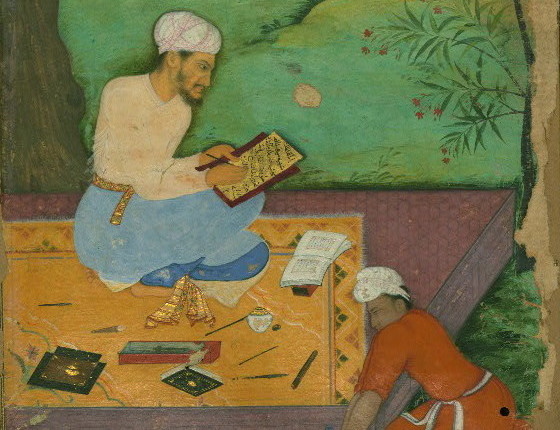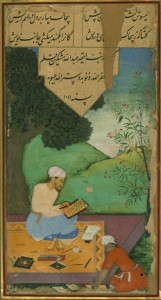
Date/Time
Friday, February 5, 2016
9:30 am PST – 5:15 pm PST
Location
UCLA Royce Hall, Room 314
10745 Dickson Plaza
Please note that the Clark Library is closed for renovations.
In 2015–16 all events are being held on UCLA’s main campus.
Core Program 2015–16
The Frontiers of Persian Learning: Testing the Limits of a Eurasian Lingua Franca, 1600–1900
Conference 2: The Social Frontiers of Persian Learning
—a conference organized by Nile Green, University of California, Los Angeles
While as one Eurasia’s great lingua francas, Persian has been rightly celebrated for its inclusiveness, bringing together Muslims, Christians, Jews, Hindus, Sikhs, and others into a single if disjointed ecumene. At the same time it has widely been conceived as the ‘Islamicate’ language par excellence. Against this apparently cosmopolitan backdrop, the second conference seeks to identify the social limits or breaking-points of Persian’s usage and usefulness. By asking whether in its connecting of different communities, Persian served more as a language of trade, governance, or literature, the conference can assess the limits of the ‘cosmopolitanism’ that has been celebrated in recent scholarship. This approach raises a series of questions. Was the wide expansion of Persian enabled but ultimately disabled by its close but constraining ties to ruling states? How did the ‘Islamicate’ profile of Persian shape the frontiers of its republic (or empire) of letters? Were there forms of social interaction or organization with which Persian could not cope? At the same time as pointing to the bridge-building achievements of Persian, by addressing such questions the conference aims to assess the social fault lines to help explain why so successful a lingua franca could dissolve so rapidly in the nineteenth century.

Speakers
Janet Afary, University of California, Santa Barbara
Abbas Amanat, Yale University
Alfrid Bustanov, European University at St. Petersburg
Michael H. Fisher, Oberlin College
Alexandre Papas, Centre national de la recherche scientifique
James Pickett, Yale University
Brian Spooner, University of Pennsylvania
Audrey Truschke, Stanford University
Liu Yingsheng, Nanjing University
Image
Portrait of the scribe Mīr ʿAbd Allāh Kātib in the company of a youth burnishing paper, with the scribe holding a piece of paper giving his name, the place of copying (Allāhābād), and the date 27 Muḥarram 1011 AH (1602 CE); from Collection of Poems (divan), written by Amir Najm al-Din Hasan Dihlavi
Walters Art Museum Ms. W.650, folio 187a
Program
9:00 a.m.
Morning Coffee and Registration
9:30 a.m.
Barbara Fuchs, University of California, Los Angeles
Welcome
Nile Green, University of California, Los Angeles
Opening Remarks
9:45 a.m.
Panel 1: Patterns and Disjunctures
Chair: Nile Green, University of California, Los Angeles
Brian Spooner, University of Pennsylvania
“The Historical Significance of the Long-Term Stability of New Persian throughout the Persianate World”
Alexandre Papas, Centre national de la recherche scientifique
“Lingua Franca or Lingua Magica? Lessons from Talismanic Scrolls from Eastern Turkestan, 18th–Early 20th Centuries”
Janet Afary, University of California, Santa Barbara
Co-authored by John R. Perry, University of Chicago
“Ali Akbar Dehkhoda: Literary and Religious Reforms of Sur-e Esrafil”
Discussion
11:45 a.m.
Lunch
1:00 p.m.
Panel 2: Comparing Cosmopolitanisms
Chair: Walter N. Hakala, University at Buffalo
Liu Yingsheng, Nanjing University
“The Zenith of Persian in China: Background, Usage, Education, and Development”
Audrey Truschke, Stanford University
“Arenas of Kingship: Sanskrit and Hindi in the Multilingual Mughal Court”
James Pickett, Yale University
“Cosmopolitan Culture into Social Currency: The High Persianate Intellectuals of Bukhara, 1747–1917”
Discussion
3:00 p.m.
Coffee Break
3:15 p.m.
Panel 3: Responses to Empire
Chair: Ali Gheissari, University of San Diego
Michael H. Fisher, Oberlin College
“Conflicting Meanings of Persian and Indo-Persianate Culture in India and in Britain for Asians and Britons: An Intimate Example from the Early 19th Century”
Alfrid Bustanov, European University at St. Petersburg
“Yunus al-Qazani and the Circulation of Persian Texts in Imperial Russia”
Abbas Amanat, Yale University
“Adib Pishavari: An Anti-imperialist Sufi Poet of Persianate Milieu”
Discussion
5:15 p.m.
Reception
Booking Form
Bookings are currently closed for this event.

